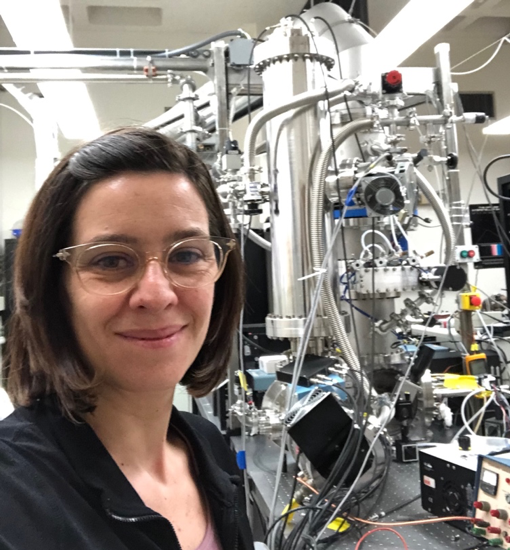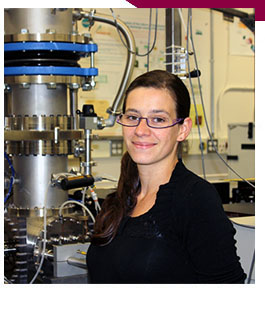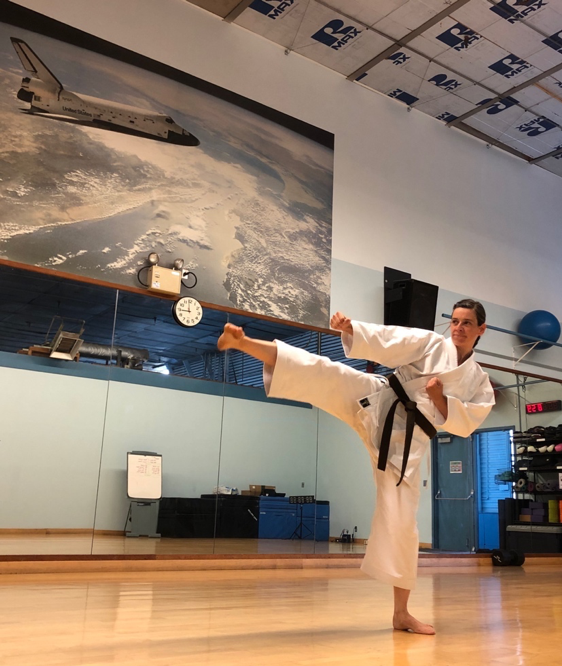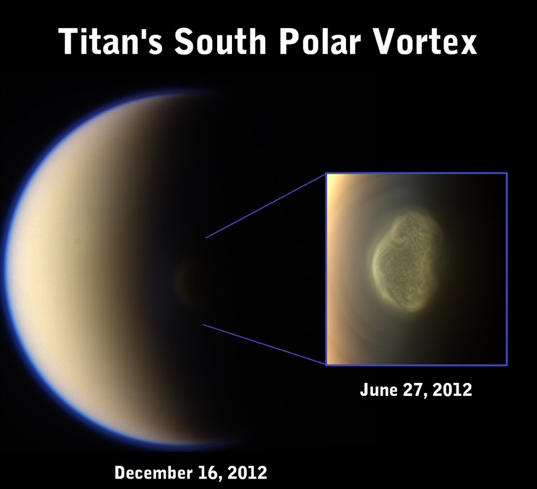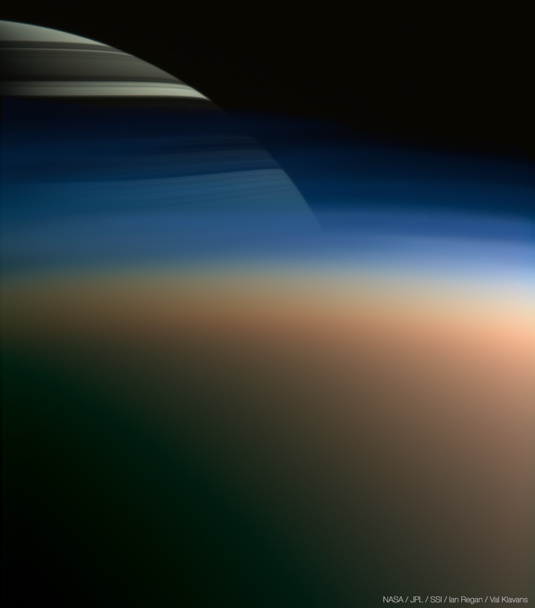We can start with your childhood, where you’re from, and if there was anything about your younger days that may have guided you toward where you are now.
I was born in France, I grew up in the southeast, close to Avignon, and I’ve always been interested in science. I was a nerd at school, I loved math in particular and always had facilities in learning it. My grandfather used to be a Math teacher and I always viewed science as a cool field to study.
Also, in my teenage years, I discovered the wonderful world of science fiction. I started reading a lot, I would read so much that I would walk from home to school reading and I got really good at avoiding people and posts and things (laughs). I was a bookworm then, I wish I could say that I’m still a bookworm now, but I don’t take the time to read as much as I’d like to. I think reading science fiction books and watching sci-fi movies contributed greatly to my fascination for space and space exploration.
So you had an interest in science and science fiction because that’s the genre that you chose to read.
Yeah, I was reading different genres but science fiction was my favorite, I got hooked after reading Isaac Asimov’s Foundation trilogy (NB: after doing this interview, I starting reading the Foundation trilogy again, it’s great!). Sci-fi books opened a completely new world. I was reading about space civilizations and exploration and I think that’s what also guided my interest in science. Also, I think that in France the education system is such that if you show aptitudes for science, even if you’re good in other fields, then they encourage you to study science and direct you into an engineering school curriculum. It was natural to do science for me and I really liked it, so I followed that direction without hesitation.
Do you take some kind of an aptitude or interest test that tells people what your interests are? When you say you are “directed” into a science course of study, someone must notice that you are good in certain areas, or is it just your grades?
It’s from your grades. I did a major in math in high school and then went to a preparation school, where for two years I took intense preparation classes for the competitive exams to get into engineering schools: ~30 hours a week of math, physics, and chemistry. I was trying to figure out what kind of engineering school I would go to. I already knew at that time that I wanted to work in a space-related field, dreaming of working for NASA one day.
Even from when you were in France?
Yes, I mean, NASA, it’s a dream even beyond the American borders. From reading books and watching movies, space exploration was NASA. As a kid growing up, I didn’t know about all the different national space agencies, the main thing you hear about in movies and books is NASA. And I wanted to explore space, so I wanted to work for NASA.
So, I was looking at a potential engineering school that would lead to a career in aerospace. I remember going to the open house of an aerospace engineering school to see if it would fit my profile. There, I was told that mechanical engineering was the way to go if I wanted to build rockets. But I was really bad in mechanical engineering, that was just not my field. Electrical engineering was what I chose to pursue instead, as it could also apply to space exploration. My preparation school’s physics teacher was teaching electrical engineering with a physics perspective, i.e. more about explaining how things work than how to use electrical engineering skills to build something. I loved it, I loved understanding the “why” and “how” and I thought “Great! I’ll go to an electrical engineering school”, I figured I would find a way to apply these skills to aerospace eventually.
I passed the competitive exam to get into an electrical engineering school in Lille, in the north of France, Ecole Polytechnique Universitaire de Lille. I studied there for three years. At the end of each year, I had to do an internship and ended up doing internships that were more about research than engineering, which resulted in me realizing at the end of my degree that I really didn’t want to work as an electrical engineer, but instead wanted to pursue a Ph.D. in experimental physics. My last year internship in Austin, Texas, where I worked on an experimental setup studying the laser ablation of silver microparticles, was pivotal in that decision.
Did you apply to a number of internships and Austin chose you, or were you trying to get into that particular program?
At the end of my engineering school, I was trying to find a way to apply my engineering background to space-related jobs, so I had applied for internships to different places including one at ESA, to develop detectors for infrared telescopes. A month before the internship was supposed to start, I still hadn’t heard back. I’m a morning person, and one day I got into the computer lab to check my emails and I saw an email from the engineering school next door saying that they had an extra internship available in Austin, Texas, and to send an email if you were interested. I was the first one to answer and I got it! I had a short month to get my passport and buy my plane tickets and then I left for new adventures in the US where I had never been before. It was one of the best decisions of my life. So, it was a combination of luck and seizing an opportunity that led to a complete change in my life and my career.
During that internship, I discovered the joys of experimental research. it was eye-opening, I loved it and realized that’s what I wanted to do. I found a professor in the electrical engineering department that was looking for a Ph.D. candidate to conduct experimental work to assess how the plasma plume from a satellite’s electrical propulsion system could interfere with the radiofrequency transmissions between the satellite and Earth. It was aligned with my expertise and related to space, perfect! After graduating from my electrical engineering school back in France I applied and got into the Ph.D. program at UT Austin. But after moving back to Texas in January 2003 to start my Ph.D., my advisor told me that he didn’t get the funding he had applied for so we didn’t have the money to develop the lab… My Ph.D. was going to be computer modeling instead. I didn’t see myself doing modeling for 5 years though. I had changed field to dive into experimental physics and that’s what I was going to do. So, I started looking for another Ph.D. subject, I talked to people, and I found a laboratory in the physics department that was collaborating with NASA’s Johnson Space Center to develop a prototype for an electric propulsion system for crewed missions to Mars: The Variable Specific Impulse Magnetoplasma Rocket (VASIMR).
Right, I was going to ask you about the NASA tie-in, because I thought that NASA probably overall was sponsoring the work that they were doing in Austin.
Yes, NASA was sponsoring my Ph.D. project. I worked for 5 years with JSC, developing a plasma emission spectroscopy diagnostic tool to characterize the performance of the VASIMR. That was really interesting, and I was taking part in NASA-related research which was exciting. The director of the lab at Johnson Space Center, Dr. Franklin Chang Diaz, was a former NASA astronaut and the Advanced Space Propulsion Laboratory (ASPL), where the prototype was developed at the time, was in the Sonny Carter Training Facility, the building housing the Neutral Buoyancy Laboratory, the world’s largest indoor pool for training astronauts. I would go work at the ASPL every few months to take spectroscopic measurements on the VASIMR, and I would see the astronauts training in the pool, it was fascinating.
At the end of my Ph.D., I realized that I wanted to modify my career path (again). I had really enjoyed my Ph.D. research, but there, I had been developing a propulsion system for someone else to explore our solar system. I wanted to find a way for me to be the one exploring space. So, I went on the hunt for a postdoc that would make the link between my expertise in plasma physics and planetary science. Oh, and in addition, just to make it a little more challenging, I was moving back to France.
I met my husband, Dan, when I did my internship in Austin in 2002, he was a Ph.D. student in electrical engineering and material sciences. We got married in 2006 and we had decided that we would move to France after graduating as we wanted to start a family and we thought it would be easier to keep both cultures in France. We wanted our kids to grow up in an environment where they could be exposed to both cultures, and the American culture is present in France through movies and music, which is not as much the case for French culture in the US. So, Dan moved to France in 2006 after graduating from his Ph.D. and I joined him after graduating in 2007. After moving to Grenoble in the Alps where he was, I looked for a postdoc position in planetary sciences that I could apply my plasma physics expertise to. It took me 11 months to find one. In the meantime, I worked as a research assistant in two different labs in Grenoble to stay active in science and learn new skills that were applicable to planetary science research. Initially, I thought I would find a postdoc research subject associated with Mars since I had been working on a propulsion system for crewed missions to Mars during my Ph.D. But then I learned about a laboratory in Paris, Laboratoire Atmosphères Milieux Observations Spatiales (then called Service d’Aéronomie), that was simulating Titan’s atmospheric chemistry in the laboratory using plasma. They had a postdoc position opened, I applied and got it. I worked in that lab for three years. It was a really interesting experimental setup and exciting research that allowed me to become part of the planetary science community through my research, my participation in conferences, and my publications.
However, my husband was still in Grenoble, which is three hours away from Paris. We would see each other only on weekends. It was really difficult, we tried to find jobs in the same city but we couldn’t, so after three years, we made the decision to go back to the U.S. where there would be more opportunities to find jobs in the same city. I started looking, trying to find a place where they would do simulations of Titan’s atmospheric chemistry and that’s when I contacted Dr. Farid Salama, here at Ames. He is the director of the NASA Ames COsmic SImulation Chamber (COSmIC) laboratory facility which, among other astrophysical applications, is an experimental platform for the Titan Haze Simulation (THS) experiment. I worked with him on defining a research project and applied for the NASA Postdoctoral Program fellowship. I was selected and moved here in 2011 to work on the THS and become a research scientist at NASA! I’ve been here for eight years now, time flies. At the end of my NPP, I got funding from a NASA ROSES grant to continue the research I was doing and I’ve been funding my research through ROSES grants and directed funding since. One year ago, I was hired as a civil servant in the Astrophysics Branch of the Space Science and Astrobiology Division. I work at NASA! It’s a dream come true.
Are you still doing plasma research?
Yes, on the THS experiment I use a plasma discharge to simulate Titan’s atmospheric chemistry. I first cool down a gas mixture representative of Titan’s atmospheric main components (nitrogen and methane) to Titan-like cold temperatures (150 K) by injecting it in a vacuum chamber through a very thin slit in order to produce a supersonic jet expansion. I then induce the chemistry between nitrogen and methane by generating a plasma discharge in the stream of that jet-cooled gas expansion. When I started my NPP, the focus of my research was to look at the gas-phase chemistry using mass spectrometry to monitor the products of the plasma-generated chemistry in real-time. I was able to demonstrate how unique the COSmIC/THS setup is to look at the first and intermediate steps as well as specific chemical pathways in Titan’s atmospheric chemistry. The research I conducted allowed us to compare our experimental results to observational results from the Cassini Plasma Spectrometer instrument and showed the potential of our experimental setup. While conducting these gas-phase experiments, I also realized that we could produce analogs of Titan’s aerosols in the THS experiment, and so I developed a new aspect of my research to look at the solid phase. In the THS, I produce grains that are analogs of the solid particles that are produced in Titan’s atmosphere and that form the orange haze surrounding Titan, making it look like a big orange ball. I can deposit these Titan aerosol analogs (also called tholins) onto different substrates that I can then extract from the vacuum chamber and analyze with different ex-situ diagnostics: scanning electron microscopy, infrared spectroscopy, mass spectrometry. This new scope of my research has resulted in several funded proposals and research projects related to Titan’s aerosols and atmospheric chemistry but also aerosol formation/composition in exoplanet atmospheres. For example, one of the projects that I currently lead is looking at the formation of benzene clouds in Titan’s atmosphere and how the aerosols might serve as nuclei for these benzene ice clouds. This is a collaborative project with observers, modelers and other experimentalists, reaching out to Earth scientists, to combine our expertise. I also have in the back of my mind to do Pluto aerosols and have been talking with several scientists here at Ames that are studying Pluto. In addition, I am involved in other experiments and other science projects more related to circumstellar environments and interstellar environments, in particular, the formation of cosmic grains in the outflow of carbon stars. There is so much potential with the experimental setup we have at Ames, and being at NASA allows for close collaborations on projects with experts in many different fields under one roof/institution.
Can you touch on how the particular work you do here advances NASA’s mission and vision of exploration, why it’s important, and why the taxpayers should be interested in funding it?
The reason why Titan is such an interesting object to study is that it is the only object in the solar system that has a dense atmosphere, mostly made of nitrogen like Earth. It’s often compared to a frozen early Earth. The experimental work I conduct here at Ames is to help better understand the very complex chemistry occurring in Titan’s atmosphere between nitrogen (N2) and methane (CH4), which are the two main constituents. We study the N2-CH4 chemistry to better understand how you go from these simple molecules to much heavier organic complex molecules and aerosols that could be precursors to life. By investigating the prebiotic chemistry on Titan, we hope to better understand what happened on Earth before life appeared. It is an exciting time for Titan research too as the next NASA New Frontiers mission, Dragonfly, will send a dual quadcopter to Titan. Dragonfly will be able to fly in Titan’s thick atmosphere and explore various locations in order to characterize the habitability of Titan’s environment, to investigate how far prebiotic chemistry has progressed, and even to search for chemical signatures that could indicate water-based and/or hydrocarbon-based life.
Could you explain more about the aerosols, why they are so important?
Aerosols are solid particles suspended in the atmosphere. The aerosols in Titan’s atmosphere form an orange haze that surrounds the whole moon. They play an important role in determining Titan’s thermal structure and can act as condensation nuclei for the formation of clouds. They can settle down to the surface and could be involved in surface chemistry. On Titan, there are also lakes, not of water but of methane and ethane, and the aerosols can settle into these lakes where additional chemistry could occur. There is a lot of processes that these aerosols can be involved in. When you look at the first pictures that were taken of Titan by Voyager, it looked like a big orange ball. And that’s because there is this thick layer of aerosols, of haze, that is hiding the surface. By understanding what the aerosols are made of and what their physical and optical properties are, we can model their contribution in the observational data, we can also better understand how they form and how they participate in the chemical processes occurring on Titan. Aerosols can also be used as nuclei for clouds, they can be involved in the condensation of volatiles at lower altitudes where the temperature is cold enough for certain molecules if present in large enough quantity to condense onto the aerosols. By understanding what the aerosols are made of, what their size is, what their morphology is, you can better understand how these clouds can form. There are clouds of different composition and at different altitudes on Titan. There is one in particular that appeared in the south pole, a really big vortex, and we’re now better understanding what it is made of. HCN and benzene ice have been detected, but some of the features from the observations are not yet identified. The question is, are aerosols involved in the nucleation and do their composition contribute to the features observed by Cassini’s instruments? That’s one of the projects I’m working on to understand the benzene condensation on Titan. And the aerosols might be key. We’re going to make Titan aerosol analogs and then condense benzene onto them and see how having aerosols present affects the condensation of benzene and how the infrared absorption spectra of benzene ice on tholins compare to observational spectra. All of this is to be able to better interpret the observational data from NASA missions.
Explain or describe what a typical day at work is for you and what you enjoy most and perhaps least about your current job.
It depends. There are some days when I’m in the COSmIC lab all day running experiments. I can either study the gas-phase chemistry in the plasma expansion with the mass spectrometer or produce solid-phase samples that will be deposited onto various substrates and then collected for further ex-situ analysis. I also have another experimental setup that I’ve developed in another lab where I can analyze the solid-phase samples, to measure their optical properties. Some days, I spend the whole day troubleshooting instruments, which is part of the experimental work, sometimes you need to fix your experimental setup or modify it to be able to do new science, and it takes time. Those are days when I’m in the lab, and I go up and down the stairs, getting things, going back. I think I lost all my baby weight in 2014 because I was running experiments and I would go up and down the stairs all the time! (laughs)
Depending on the type of experiment, it can be a short day (6 hours for gas-phase experiments) or a long “day” (up to 40 hours for solid-phase experiments). For some of the solid phase experiments, because we don’t produce that much material, we need to run the plasma for up to 40 hours if we want to have enough deposits to do ex-situ analysis afterward. In that case, there are several people working on the experiment and you do shifts, but it can still make for a very long day in the lab. It is rewarding though when you open the chamber the next day and you have a beautiful sample to analyze.
The lab is kind of like your fieldwork, then?
Yes, in a way, that’s true. It’s intense but really exciting when your experiment is running.
I sense from your description that it’s your favorite part of the job.
I’m an experimentalist, so yes, being in the lab is fun.
Is there a part of your job that you enjoy less?
I don’t know if I would say that I enjoy it less, it’s just a different part of my job. I spend a lot of time on the computer writing proposals, writing papers, communicating with collaborators and other investigators via email, preparing presentations for conferences (fun) and also doing all the travel paperwork (less fun). I go on travel two or three times a year, which is exciting because you get to communicate with other scientists, learn from their research and show them your research results, and find new collaborations and new ways to do your research.
With my new position as a civil servant, I’ve been asked to do more administrative things too, and am more involved in budget determination, making sure all the money is coming to Ames and going to the right person in the right way. I guess that is my least favorite part of the job, dealing with budgets, but it’s a necessary task and I’ve learned a lot in the last few months.
Interacting with the team, trying to get organized, finding ways for our team to work together and accomplish our milestones in time, that’s been exciting too. It’s not the same as being in the lab but it’s more challenging in a way because it’s something that I haven’t done as much. If I think of where I want to be in ten years, I can see myself more into project management, so this is a great platform to get exposed to that aspect of the job.
Any high points so far in your young career, you have a lot of experience but you’re still young, in terms of breakthroughs, discoveries, interesting things that you’ve found?
Well, one of the most exciting events was the first time I demonstrated that we were generating solid grains in suspension in the gas phase in our experiments and that we could deposit them onto a substrate and then analyze our sample. I took a sample and brought it to the scanning electron microscope (SEM) in building 239 at Ames, and I looked at it and I saw this huge grain (5 µm in diameter); which we didn’t think we were making. That was really exciting! And that had implications not only for Titan but also for cosmic grains, which was another aspect of the COSmIC lab. It was an important step for our laboratory, it got everybody excited.
You’ve already told us that your dream job is the one you have now, but other than this job, have you ever had an idea of something else you’d like to pursue, semi-equally with your interest in your research here?
There are many, but I wouldn’t call them my dream job. When I was growing up, volcanology and bookbinding (for very old books) appealed to me. It seems when you’re growing up you think “I want to do this! I want to do that!” or at least that’s how I was every time I discovered a new type of career that was exciting. During my Ph.D., when I got frustrated with my research, I would think “ok, I’m done, I’m just going to go to Buenos Aires and be a tango teacher!” I’ve been doing tango for more than 20 years.
But my dream job is really the job I have now, working at NASA as a research space scientist.
I guess something that would top it off would be to become an astronaut!
What advice would you give to an aspiring young scientific oriented researcher who would like to have a job like you have?
That the straight path is not always the right one. That if you started in one direction and you realize it doesn’t look like the right one, it’s OK to change. It’s not a mistake, it’s just finding out what you really want to do. Sometimes you need to do something you don’t want to do, to find out you want to do something else. It doesn’t have to be straight and you don’t have to know what you want to do from the beginning. Give yourself the right to change your mind. So that’s one advice.
The second advice is to not choose your Ph.D. or your postdoc subject only; you want to choose who you want to work with as well. It’s really important to be in an environment where you have a good interaction with people and are supported by the people you work with, where you can grow in your career and your group. And that was one of the amazing things about Ames, how the network of scientists who were there allowed me to grow and find the right path for me.
Would you like to share anything about your family: kids, pets, hobbies?
Well, I’m happily married to Dan, we’ve been together for 17 years and we have two kids, Liam who is eight and Nina who is five. Nina was at the NASA daycare until a few months ago, like Liam before her. They are now both at the public school in our neighborhood, Liam is in 3rd grade and Nina in Kindergarten. They are amazing kids (of course), curious and kind and funny.
What do you do for fun?
I dance tango when I’m not super tired. I haven’t done it for a while because it’s been quite intense in the last few months but usually, I try to dance once a week. I love it. It’s a way to express my creativity.
And then I do karate!
I was going to ask about that because the other morning I passed you in the hallway and you were wearing martial arts clothing. That was unexpected, but also so early in the morning. Do you go to an early morning class?
Yeah, so it’s only two of us, on Tuesday and Friday mornings. I used to do karate when I was doing my Ph.D. and I haven’t done it in ten years but I have a new postdoc in my group, David Dubois, and he’s a black belt karate teacher. We were really excited when we were thinking of him coming to Ames to do a postdoc and we said “Yes! We’ll do karate!” We started last week at the fitness center. It’s really exciting and I’m really sore!
Is there an accomplishment that you’re most proud of that is not science-related?
There is one thing that I’m proud of even though it didn’t end up working out in the end. When I moved back to France in 2007, I wanted to explore space and ESA was opening up their astronaut program again, so I applied. We were 9,000 candidates to start with. I passed the first selection and we were 800 to do so. Then I went to Germany to do some psychotechnical tests, and I passed. We were now 190 left. The next step was a full day of psychological tests, and I didn’t pass that one. But I was one of 190 out of 9,000, so I’m proud to have gone that far! And it was a fantastic experience.
What did they ask about in the psychological test?
There were different exercises. One of them was to see how well you could lead someone efficiently to conduct a task and then the roles were reversed to see if you could follow instructions. Another exercise was kind of like the Rorschach psychological test with the ink blocks, but here there were drawing of hands in different positions and you had to say what these hands were doing. And there was a group exercise where all the candidates for that day (we were only 6) had to deal with this crazy hypothetical situation where part of your team is lost and you have to go and find them and they give you different paths that you can take and there are different risks and difficulties on each path. You have to choose as a team what you are going to do, and they look at who is leading and who is following, how you interact with other people. And there were two long tests (45-60 min each) on the computer asking crazy questions like “Do you think you are being followed?” (laughs) “Are you afraid of spiders?” (I am…) there were thousands of questions. And at the end of the day, you had an interview one on one with a team of psychologists, engineers, and an astronaut. It was intense. Out of the 190, they kept 40 that went through physical tests and then individual interviews.
Who or what inspires you? Have you ever thought about that?
I guess Isaac Asimov has inspired me, to explore, to continue to be fascinated with science and to be curious. A fun fact is that my son’s middle name is Elijah, like Elijah Baley, one of Asimov’s characters. So, Asimov has inspired me in more ways than just my career path!
What is your favorite space image and perhaps a favorite quote?
It is difficult to choose just one image because there are so many amazing images of space that have been taken over the years. I chose two images taken by the Cassini Imaging Science Subsystem (ISS) and processed by Val Klavans. Unsurprisingly, both are images of Titan. The first image shows the entire world, you can see the haze and the south polar cloud system that I am studying. The second image shows Saturn through Titan’s haze, When I saw it, it reminded me of a fun story that I thought I would share. In the Star Trek XI movie, there is a very similar scene where the Enterprise drops out of warp in Titan’s atmosphere to hide. I remember squealing a little in the theater when I saw that scene. I must have been the only person in the theater to be super excited about it (laughs).
For the quote I go back to Isaac Asimov. There is one from the Foundation trilogy that I think is true most of the time: “Violence is the last refuge of the incompetent”.
But my favorite quote, more related to science, is this one: “The most exciting phrase to hear in science, the one that heralds new discoveries, is not “Eureka” but “That’s funny””. I really like that one.
Thank you!
Interview conducted by Fred and Sara on May 23, 2019
























